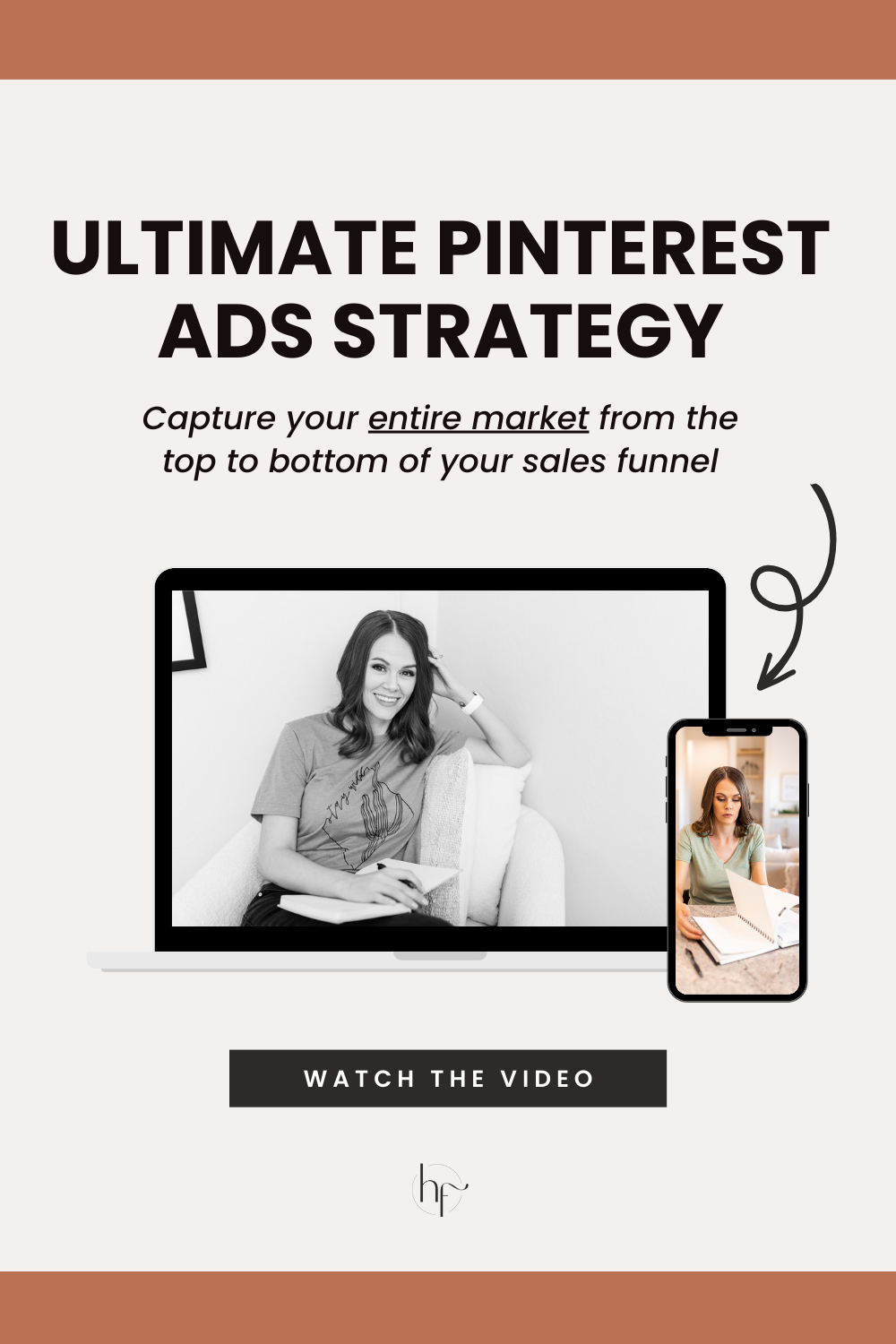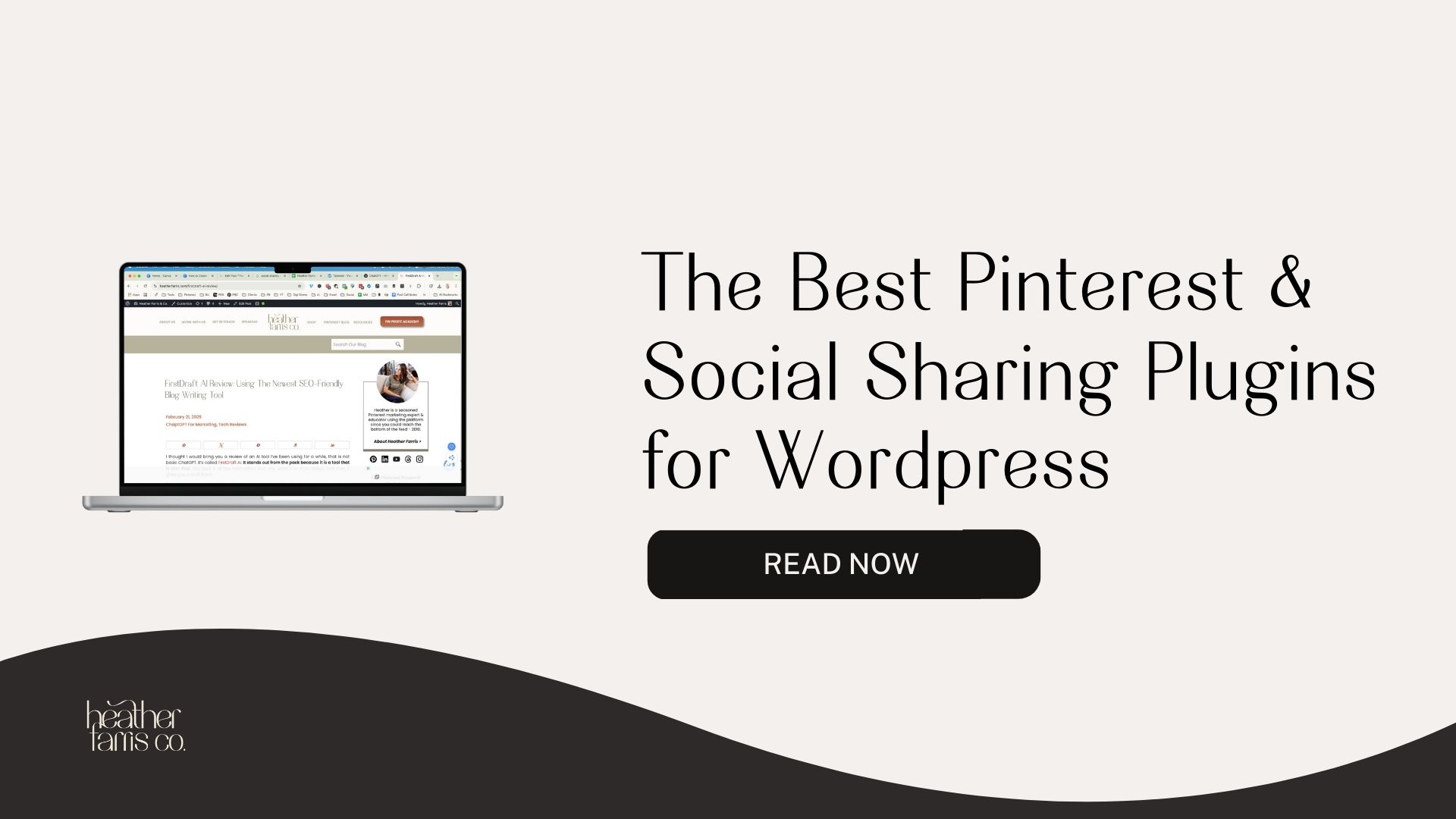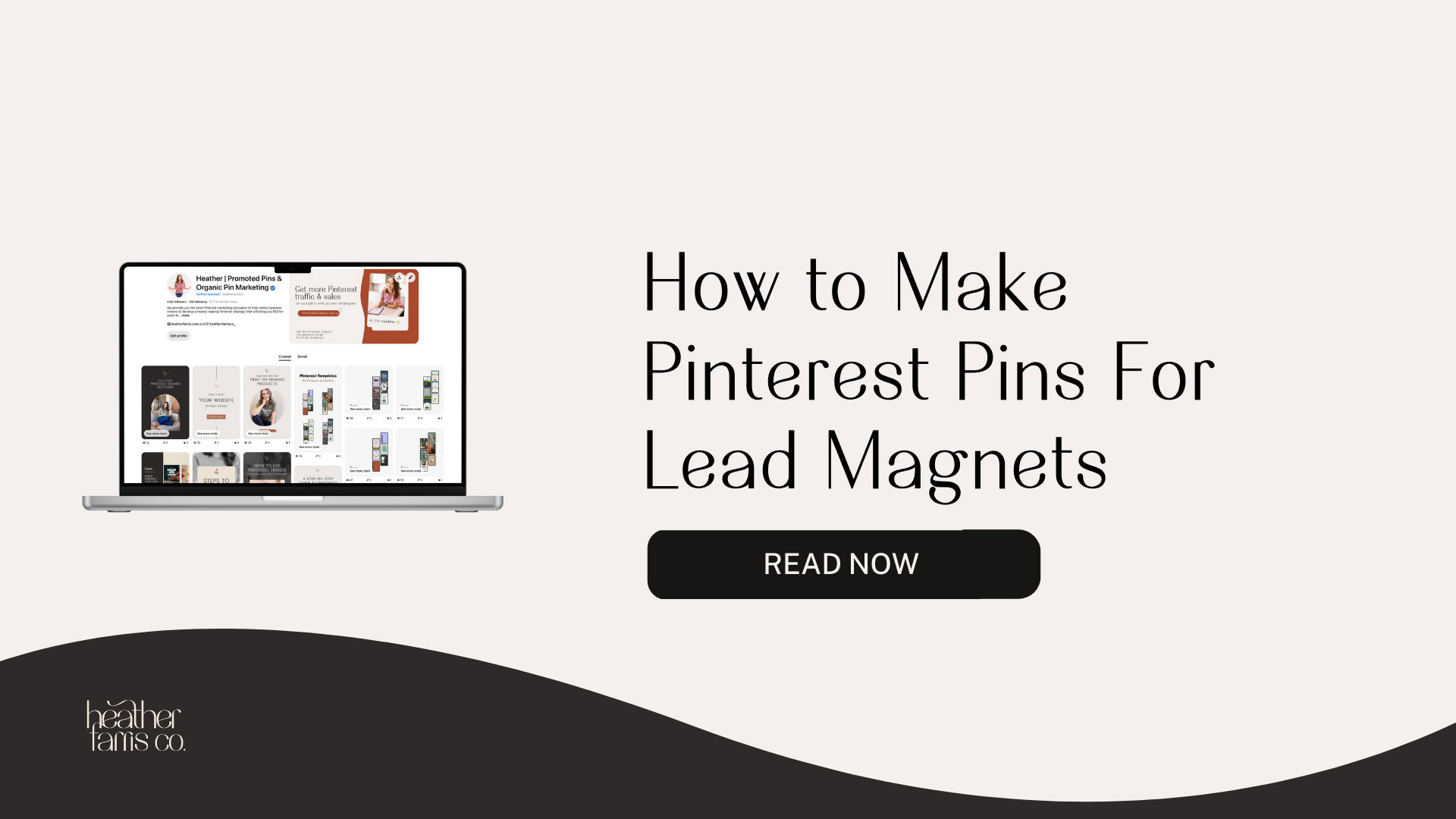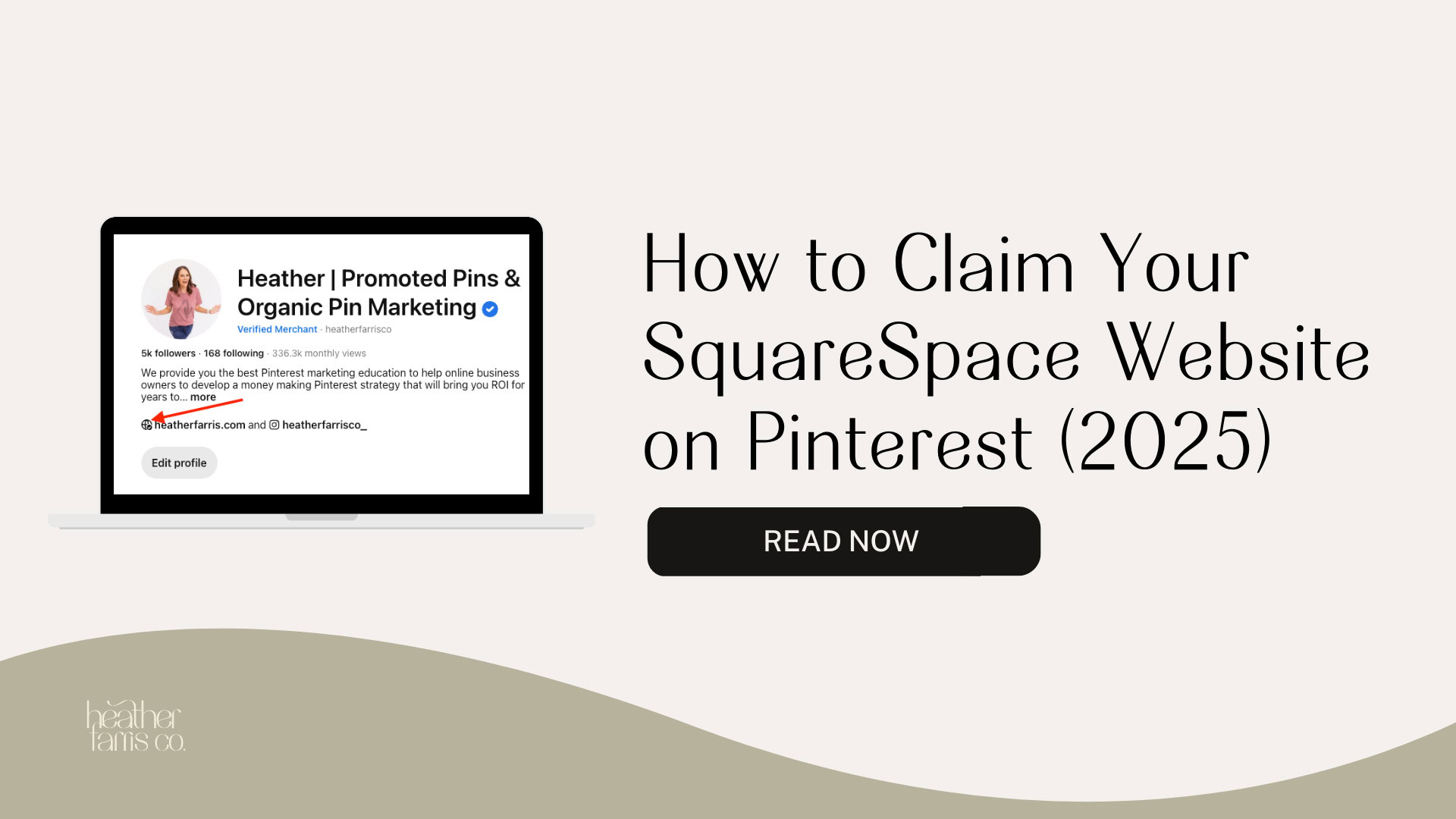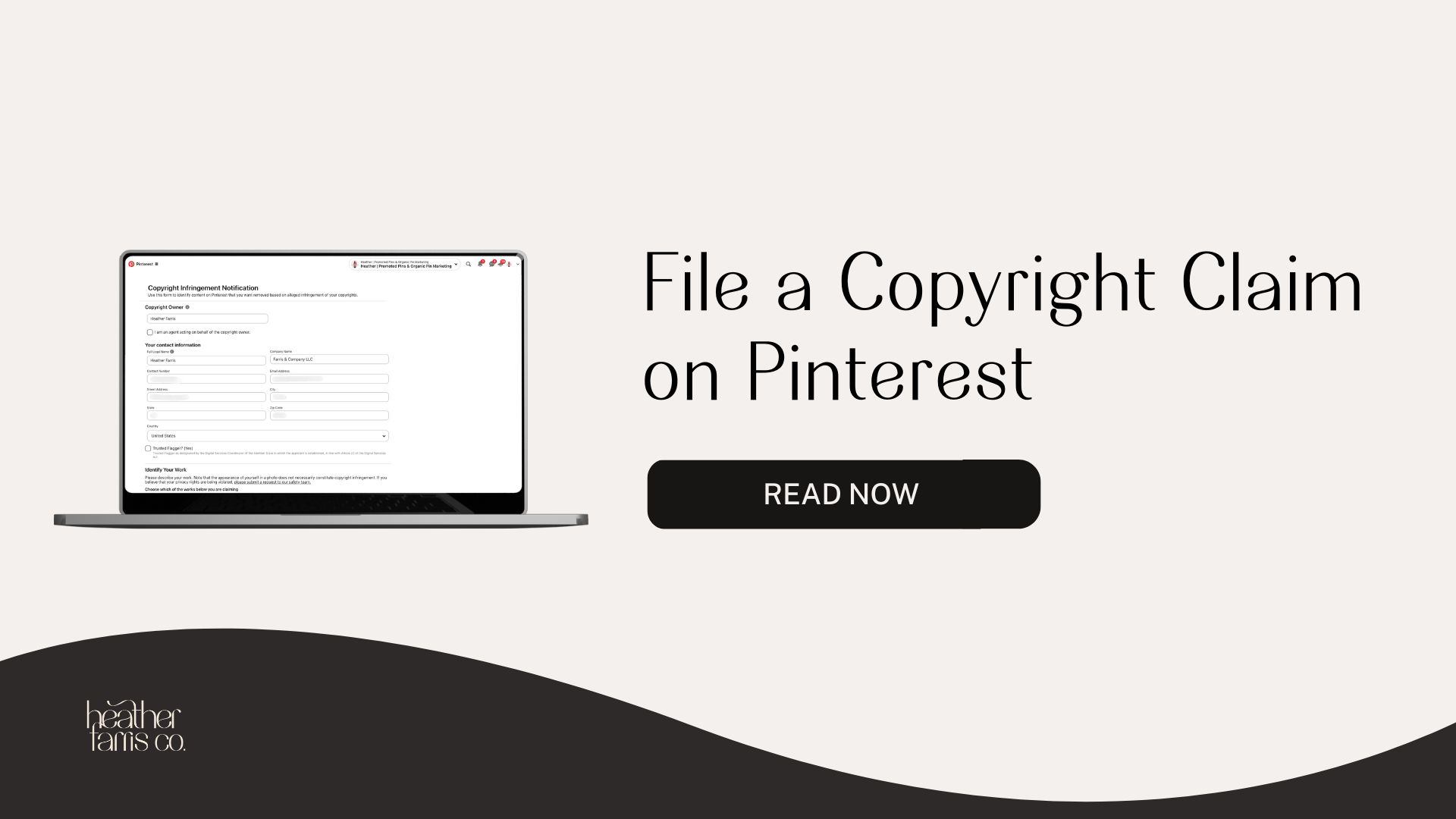Heather is a seasoned
Pinterest marketing expert & educator using the platform since you could reach the bottom of the feed - 2010.
About Heather Farris >
Ultimate Full Funnel Pinterest Ads Strategy That Got 26X Return
April 6, 2023
Are you ready to go all in on Pinterest with a full-funnel ad strategy or scale up what you are already doing and make the most of your ad budget? Today I’m going to walk you through a full-funnel Pinterest ads strategy. You have been asking for this, so I’m bringing it to you.
I’ve been running ads for clients in both the e-commerce and content marketing space since 2019. I’ve seen several things that have worked well and many things that have not worked very well. So, to know whether or not it will work for you, I suggest you start with one or two of these campaigns if you are brand new to advertising.
If you are not new to advertising and you’ve had your pixel on your website for a while and
you are already getting sales to your products through campaigns on Facebook, Instagram, TikTok, Google, or Pinterest… I would suggest the full-funnel campaigns for you.
If you are new, hold up on full-funnel because you really need to have a primed audience and conversions for this to work. So without further ado, let’s dive into a full-funnel ads strategy.
RELATED: 12 Pinterest Audiences to Use to Make More Money on Your Ads
What does a full-funnel Pinterest ads strategy mean?
It is the same as any other platform. However, a good Pinterest ads strategy includes top-of-funnel, middle-of-funnel, and bottom-of-funnel ads. So you are running multiple campaigns where the majority of your spend is in the top and middle-of-funnel, and the least amount is in the bottom-of-funnel.
We have awareness, consideration, and purchase. So if you think of this in a funnel format:
- Top of funnel – awareness (That’s the majority of your audience.)
- Middle of funnel – consideration
- Bottom of funnel – purchase
The general industry benchmarks are 80% top and 20% bottom. Now, here is the kicker. The middle-of-funnel is the bridge between the top and the bottom. So in a lot of cases, the middle-of-funnel is going to get muddied into the top and the bottom of the funnel.
So, as I begin to explain middle and top-of-funnel campaigns, you’ll notice some of the creatives could fit both top and middle. Some of the calls to action are similar. Some of the landing pages and the audiences are similar. This is because the middle-of-funnel is the consideration phase of a buyer journey. So the middle is going to muddy itself into both. Just be aware of that.
RELATED: Why You Need a Content Strategy Before You Ever Begin Marketing

Pinterest Ads Starter Pack + Pinterest Ads Templates for Canva
Wondering how to get started with Pinterest ads but not really sure how? Look no further!
This starter pack includes everything you need to jumpstart your Pinterest ads including my exclusive 24 page promoted pins guide.
This detailed starter kit will help you to understand the Pinterest ads ecosystem.
Top-of-funnel campaigns
Let’s talk about top-of-funnel campaigns on Pinterest and other platforms. Top-of-funnel campaigns are there to bring awareness to the problem. This is a very early awareness phase, and I have examples for you. So let me lay those out.
A problem for the top-of-funnel could be: My cabinets are disorganized, and I’m having difficulty finding things.
The solution could be: Learning how to organize your pantry cabinets better.
So this is very much awareness, becoming aware that I can’t find a darn thing in my cabinets. My entire family doesn’t know how to put things away the right way, the way that I want them. Could I be speaking from experience here? Quite possibly. But that’s the problem, right? And we’re bringing them to an awareness that that is their problem. Then to the solution, I have this list of solutions for you.
Campaign objectives
Campaign objectives for the top-of-funnel pinterest ads strategy will be:
- Consideration
- Brand awareness
- Video views
Those are the campaign objectives on Pinterest you can use for top-of-funnel.
I primarily use only consideration on Pinterest for top-of-funnel because I can do brand awareness and video views in a consideration campaign. I do not need to be billed in any other way other than by clicks, which is typically the cheapest for consideration on Pinterest. So, there are three options, and I always use consideration.
The landing pages where you’re going to send people in a top-of-funnel campaign will be product landing pages. This could be a full landing page showcasing the product and the problem it solved, almost like a sales page. You could also send them to blog posts or lead gen.
So if you are solving a solution with an ebook, PDF, or something like that, you can send them there. And this is a very much cold audience and what we’re doing is:
- collecting emails
- engaging an audience of people
- getting pixel data on their computers
- then we will further qualify them in the next level, which is the middle-of-funnel.
RELATED: How to Use Pinterest to Grow Your Email List (The Ultimate Guide)
Audiences
The the aspects for findings audiences you can use in your top-of-funnel campaigns are cold, broad, keyword-targeting, and interests, which are more broad. You’re selecting broader interests and then defining those down later with expanded targeting. So, cold, broad audiences, which encompass interest and keywords, as well as expanded targeting.
Expanded targeting means if someone is browsing in the organizing space, I also want them to see these cleaning products. It’s finding people who are similar enough and showing them your ad. So to reach more audiences, you can use expanded targeting with your Pinterest ads strategy.
RELATED: 12 Pinterest Audiences to Use to Make More Money on Your Ads
Optimal creatives
Optimal creatives for a top-of-funnel campaign will be video ads, static ads, and carousel ads. These can be positioned with messaging that is very aspirational. I’m going to show you some examples.
Organized Pantry Ideas
So we have someone looking for how to organize a pantry. Home Depot is giving us a creative saying, “Hey, here are some ideas for an organized pantry. ” This is landing you on a blog post on their website.
Find Your Style Luxury Ranges
So if someone is looking for kitchen and pantry stuff, they may also be interested in remodeling their kitchen. That’s where Build with Ferguson’s ad comes in.
Appliances For Your Dream Kitchen
That’s where Premium Home Source’s creative comes in. There’s an arrow pointing to the dishwasher.
LG’s stackable washer and dryer
I want this set-up myself. I might have clicked on the ad to see how much they were. It says, “Get it done with one,” meaning one unit. Not having to go to multiple places is great. I think this creative is fantastic. And then, they have a call to action of ‘Shop Now.’
Here are some further examples of ad copy you can use in top-of-funnel content.
- Organized pantry ideas
- Get the organized pantry of your dreams
- Organize the mess, reduce the stress
- Find your ‘—’ style
So you can do a mix of this kind of aspirational messaging. You want to showcase the product, the product wants to be the focus of the imagery, and you really want to help people understand that this could be the solution to the problem they just became aware of or were searching for..
RELATED: 7 Ways to Generate Content Ideas Even When You’re Not Feeling Creative
Calls to action
Let’s talk calls to action for top-of-funnel campaigns with your Pinterest ads strategy. These are very broad, but we use many of these throughout our campaigns on Pinterest.
- Learn more
- Shop now
- Buy now
- Download
- Sign up
- Watch more
We basically want to make them aware that there is more for them to learn. This is so they’ll click through and stay engaged longer, becoming more familiar with your content, and possibly becoming a regular follower or customer.
RELATED: How to Get More Clicks on Your Pinterest Pins
Middle-of-funnel Pinterest ads strategy
We want to qualify all of that cold traffic in the middle-of-funnel campaign. We want to qualify them further down into consideration. So we want to push out any tire kickers and keep in only our ideal audience.
Many middle-of-funnel ad strategies online will tell you that these should be warm audiences. You should be using versions of your audiences that you created in the past based on your email lists and things like that, where you’ve captured some of their information.
In all honesty, many people’s middle-of-funnel strategies look like retargeting to me. However, for me, middle-of-funnel is further refining what we were doing in the top-of-funnel to qualify people for the middle-of-funnel campaign further. This campaign bridges the gap between the top and the middle and top and bottom.
Campaign objectives
Your campaign types for the middle of funnel are going to be:
- Conversion
- Catalog sales
These are meant to drive action. They are optimized based on events that happen with viewers. They are billed based on impression. You can run consideration campaigns on top of funnel and be billed per click and only pay when someone clicks on your ad.
In the middle-of-funnel, we are going to be billed by 1000 eyeballs. So you’ll want to be billed on impressions here. Landing pages for your middle-of-funnel ads will include product pages to product listings. You can also do product landing pages.
You could do lead generation for specific items. So if you wanted to offer a percentage off, you could do that at this point. We’ve pre-qualified them a bit in top-of-funnel and made them aware. Perhaps they’ve been on the landing page, and now we want to bring them into middle-of-funnel and offer them a little discount to get them to purchase and check out. More on discounts later.
Customer example
We’ve identified we have a pantry problem. The problem in middle-of-funnel could be a customer thinking “my cereal is stale, and I desperately need organizing bins.” This is where the creative in this example will vastly differ from top-of-funnel.
So if our problem has been figured out, we know we have an organizing problem. Now we know we have a stale cereal problem. From there we can sell organizing bins or storage containers.
RELATED: Tripwire Funnel: How to Create a Powerful Lead Generation Machine
Audiences
Audiences for the middle-of-funnel Pinterest ads strategy are act-alike audiences based on events from the top-of-funnel. So if someone signed up or went to the website and added something to their shopping cart, we want audiences built off those past actions taken. So using an email list of sign-ups and any events taken place on your website, you can build act-alike audiences off of what you have and try to bring in more people like the people who already were on the site or pre-qualifying.
We are also going to use the ‘refined interest’ like from the top-of-funnel. So, in top-of-funnel, we’re running more broad interest targeting. Maybe we’re running all of the finance, and within all finance, we’ve selected level-two interests like banking, credit cards, etc.
In the middle-of-funnel part of this strategy, we will refine the things that were not working in the top-of-funnel. We will only use the things in middle-of-funnel that were working, as far as interests.
Along the same lines, we’ll use more phrase-match and exact-match keywords in our campaigns because we know that’s what people were clicking on, signing up for, and adding to cart within top-of-funnel. In middle-of-funnel, those are the only things we want in the campaign to qualify them.
Optimal creatives
Optimal creatives for middle-of-funnel are video ads, static ads, and carousel ads. These are standard across all campaigns. However, your messaging on these can change. When we’re talking about ad copy in middle-of-funnel, if you’re running prospecting campaigns with catalogs, you’re probably not going to have a lot of text overlay on those because these catalog images are coming from your website. So you’re heavily going to rely on titles in this case.
I was searching on Pinterest for pantry organization containers. As you can see in some of these examples, Amazon always runs images with a ‘Shop Now’ button at the bottom, with their logo at the top. They rely heavily on pin titles.
Tidy Up With Duck brand
This is a specific brand of product. I’m unaware of this brand, but it’s interesting to me, which is why I screenshot the product. It just says “Pantry Organization.” This is a very weak ad, but the creative was really compelling because it was a video on top showing a fully organized pantry, and then it was just an image of the products on the bottom. So the creative was compelling, but the copy was not.
Home Depot
The next one is from Home Depot. Home Depot is a very strong advertiser here and has a great Pinterest ads strategy. They’ve gone from organized pantry ideas to kitchen organizing solutions. The key, in this example, is the language they’re using. For the top-of-funnel, they’re saying “Ideas”, but for the middle-of-funnel, they’re saying “Solutions.” These are solutions to the problem that you have.
And then the middle-of-funnel landing page is a guide. It’s like a webpage landing page with all the different options on their website. It says: “Organize your kitchen cabinets and say goodbye to clutter with help from Home Depot.” It’s a very strong creative from Home Depot.
Conversion Campaign Creatives
The following examples are conversion campaigns. I was searching for cereal organization products. One of the images says: “#1 Way to Store Your Cereal.”
The second one is a video, and it says: “Rice dispenser, food storage containers, glass container with airtight bamboo lids…” This copy is not the greatest or the strongest, but the video itself was compelling, which is why I screenshot it.
I like these two. I think I would marry the “#1 Way to Store Your Cereal” text overlay onto the second one with the rice storage video. Then I would take the pin title from the cereal storage pin and put it on the rice storage pin. Marry those two together to make a killer creative.
So that one says: “The best way to store your cereal, so it stays fresh.” That’s what I want. That’s my problem. I need that.
The final two examples in this series are catalog pins. These are coming straight in from The Container Store and JC Penney. These are catalog images from the products they sell online. So they are relying very heavily on the pin titles. There is no text on the images, and the images are square.
So you can see how you can have a mix in the middle of funnel. You can have conversion campaigns where you run all your own imagery. You can have imagery as a hero in a collection with a collection of catalog pins underneath and a hero image above. And then you have just catalog images.
RELATED: Promoted Pins on Pinterest: How to Setup & Optimize Your Conversion Campaigns
Ad Copy and Calls to Action
Let’s talk ad copy and call to action for the middle-of-funnel Pinterest ads strategy. You want to call out the solution like Home Depot did, using catalog images. You can skip the text overlays and just go straight for pin titles. This is where you want to ensure that your website copy is on point because your catalog ads feed from your website. And if your website copy sucks, it will not convert well on Pinterest either.
Here are some examples of copy you can use for middle-of-funnel:
- Food Storage Dispensers to Keep Your Cereal Fresh
- The Best Way to Store Your Cereal
- Food storage containers for “—”
- Shop a selection of panty and food organizing products
- Organize your pantry with products
You can see how you can mold those into other niches and fit your needs.
RELATED: Starting Pinterest Ads For the First Time? I Would NOT Do This…
Call to action
Let’s talk calls to action quickly:
- Shop now
- Buy now
- Explore the ‘thing’ (that’s what Home Depot was doing)
- Get started
These are all common examples of calls to action in the middle-of-funnel.
Bottom-of-funnel Pinterest ads strategy
Let us talk bottom-of-funnel strategies for advertising on Pinterest. This last section is the shortest. I don’t have many creative examples at the bottom-of-funnel because I have not been doing a lot of shopping lately.
Campaign objectives
The whole point of bottom-of-funnel campaign ads is to drive sales. We want to drive sales in almost all cases. Even for content creators, bottom-of-funnel campaigns should be to sell products. So if you got them into a webinar, bottom-of-funnel campaigns should be to sell the product you are pitching in the webinar.
If you are doing lead generation like I am on Pinterest, where I am giving my strategy guide away for free, my goal is to sell the thing behind it, which is my membership or a course. Campaign types at the bottom-of-funnel will be conversions for most of everyone. For e-commerce, you are going to use catalog dynamic retargeting campaigns.
Landing pages for this are pretty simple: product listings or your shopping cart
If you can get people back to your shopping cart, that is fantastic. If you don’t have that capability, send them straight back to the product listing.
RELATED: Pinterest For E-Commerce in 2022: Pinning tactics for product sellers
Audiences
Audiences for this are pretty simple: hot leads. We want to retarget:
- page visits
- add to carts
- checkouts
Anyone that has previously fired an event or has been pixeled on your website and they are hot, we want to bring them right back. You can also add events based on email lists. So if you have an email list of fires, an email list of people who have added to the cart and have abandoned, or anything like that, you can also utilize that. I would not use the entire email list in this case, but segments of it that are hot and active.
You don’t want to start with small email lists; you need a minimum of 100 people. Even then, it will be really small. So remember, this part of your audience is the smallest. You want the most qualified selection, which is where you will layer in events I listed above to retarget.
RELATED: Retargeting Ads on Pinterest: How & Why to Use Them
Optimal creatives
Let us talk about optimal creatives. So, in this part of your Pinterest ads strategy, I want you to utilize:
- testimonials
- Reviews
- social proof
- any of that kind of content that you can get
In a lot of cases, this is user-generated content (UGC). So, if you have a heavy UGC product or heavy UGC content that you can utilize, this will be great for retargeting.
Now you cannot use videos in the catalog dynamic retargeting campaigns. You can use hero images. You can utilize creating a Pinterest image and have reviews, testimonials, and things like that on that image. However, you cannot use videos in dynamic retargeting.
If you want to set up conversion retargeting, you can use any other creative that you make. So it’s two different ways in a lot of cases for e-commerce. Just be aware of that.
Bottom of funnel promoted pin examples
Volkswagen car
I’ve not been doing a lot of shopping lately. I have done one thing lately: I have bought a new car. I was recently at the Volkswagen dealership, was on their website, signing their credit application, and all that stuff. So they have my information not only from purchasing a car but also from being on their website. I’m pixeled; I filled out all this information, so now I’m seeing retargeting-style ads for the car I purchased.
In this example, the call out is: “We struck oil.” This is a play on combustion engines. It’s an electric vehicle that I bought. There’s a lot of fine text at the bottom, and then the pin title is: “The all-electric ID.4 SUV.”
So this is the only example I have of my own behavior on Pinterest right now.
For the other two examples, I went and shopped around online. I added things to the cart, I shopped around on Pinterest, and then I found two examples that I think are good. It happens that quickly.
Mattresses and bedsheets
These are testimonials or social proof-style pins. They’re both mattresses, but the first one is of a man lying in bed, and it says: “So insanely soft. These eucalyptus sheets make it impossible to get out of bed. Learn more.”
To me, this ‘Learn More’ feels like the top or middle-of-funnel, but with customer language on it, it feels very bottom-of-funnel.
The other example is from Big Fig, the mattress for bigger figures. I was on this website based on a TikTok video where this guy who’s 7 feet tall was given a bed, and I’m pretty sure it’s the same website. They gave him his bed, and his feet finally fit. His whole body fit on the mattress, and this pin came up.
This quote is from someone named Renee: “I bought the bed to hold up my husband’s weight, but I too am enjoying a firm night’s sleep on a simply better made bed. Renee.” It’s got a picture of husband and wife or partners facing each other, sleeping on the bed. There’s no solid call-to-action like Shop Now or anything like that, but it’s a direct review.
I have not been doing a lot of shopping lately, so I don’t have hard examples, but use testimonials, use social proof, and use all of those things in your bottom of the funnel Pinterest ads strategy.
Call to actions
The call to actions here is very similar to the top and middle of funnel.
- Buy now
- Shop now
- ‘You forgot something’ language
- Percentage off or dollar off
- Discount language
- Pricing callouts
- Free shipping callouts
- Free trials
- Free gift with purchase
All this language is great for a call-to-action in the bottom-of-funnel. It helps to push people over the fence to purchase.
Final thoughts on the ultimate Pinterest ads strategy
If you want help running your advertising or learning more about ads on Pinterest going into 2023, you should choose your path right now.
- Join the Academy to learn and do it yourself, where you can get some support from me weekly in one-on-one or in Q&A calls in a group setting.
- You can also work with us. Just fill out the application to hire my team to run your ads.
Those are your two calls to action for this week. If you’d rather learn more about Pinterest advertising, head over and watch my Pinterest ads videos playlist. I will see you next week.
Pin it for later
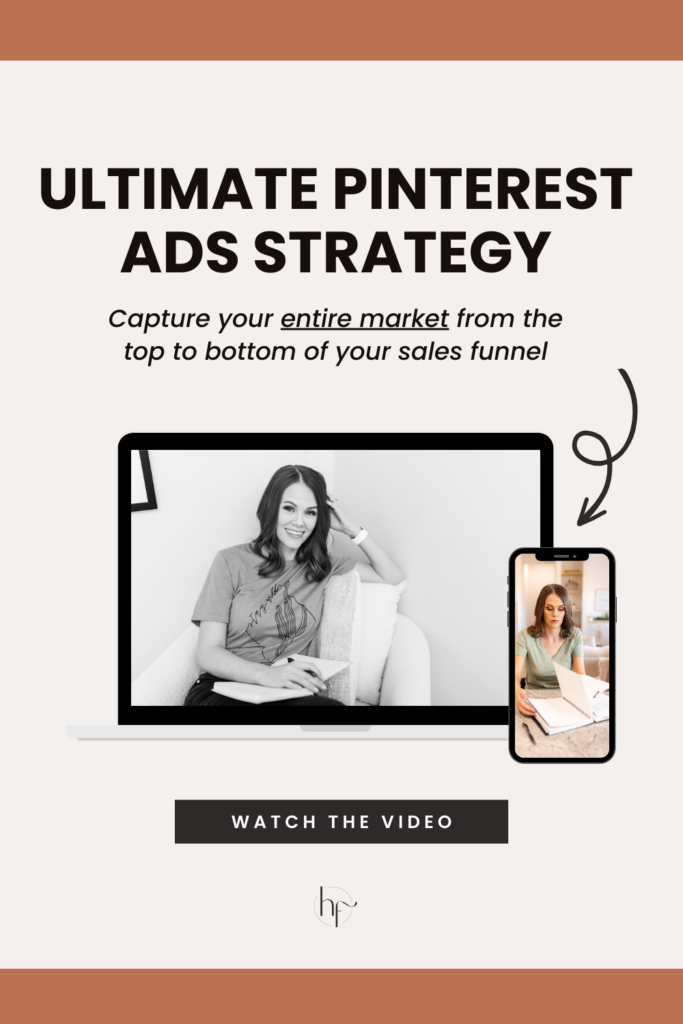
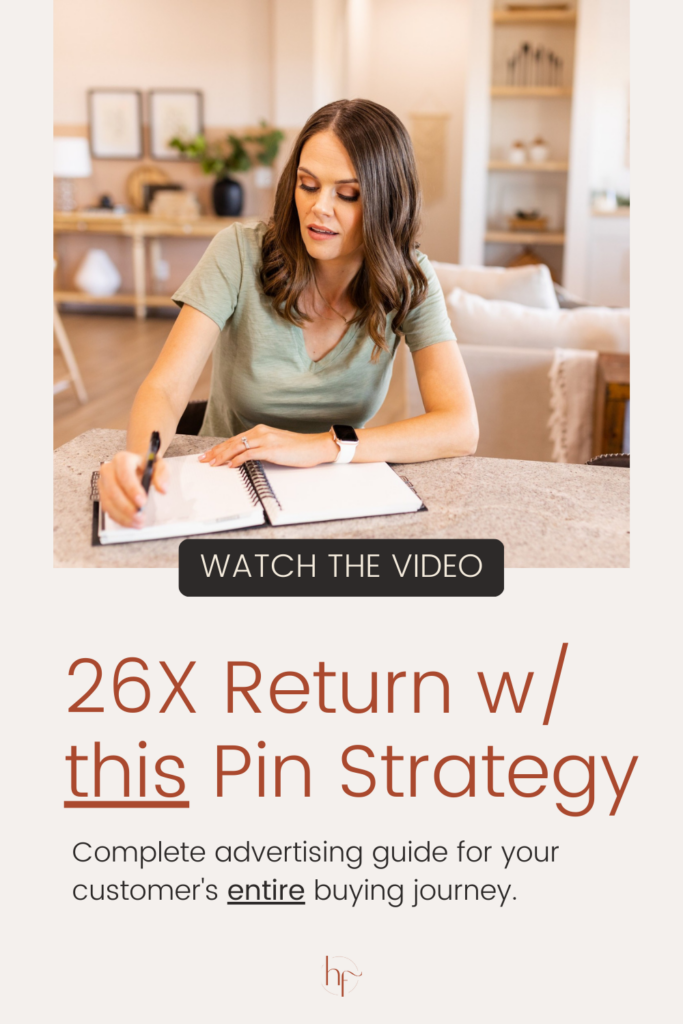
Heather Farris went to school for accounting and worked for years in banking and finance. After finding all of that entirely too boring she started her first blog in her basement in August of 2016. She has started 3 blogs in the marketing, motherhood and travel niches and used Pinterest to grow them all. She quickly became the go-to Pinterest strategist in her peer circles and has been implementing strategies, driving traffic and sales through organic and paid tactics for her clients. On this blog and her YouTube channel, as a renowned Pinterest marketing expert, she educates the public about clear and transparent marketing strategies to help them to grow on Pinterest and in other places online as a renowned Pinterest marketing expert.
